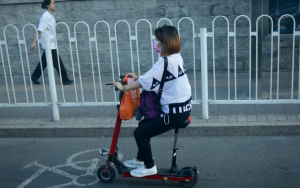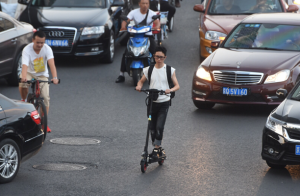E-scooters are legal in China under strict regulations, and they are immensely popular, especially in urban areas.
Overview of E-Scooters in China
History of E-Scooters in China
Electric scooters, known for their convenience and cost-efficiency, have a relatively recent history in China. The inception of e-scooters in the country dates back to the early 2000s. Initially introduced as a novel mode of transportation, they quickly gained popularity due to their affordability and ease of use. The evolution of e-scooters saw significant advancements in battery technology, improving both their range and speed. By the mid-2000s, e-scooters had become a common sight in urban areas, substantially altering the urban transportation landscape.
Current Market Size
The market size of e-scooters in China has seen a remarkable increase over the years. As of the latest data, China is not only the largest manufacturer but also the biggest market for electric scooters globally. The industry’s growth is propelled by factors like increasing urbanization, environmental awareness, and supportive government policies. In terms of numbers, the market is estimated to be worth several billion dollars, with millions of units sold annually. The consumer base primarily consists of young adults and commuters who favor e-scooters for their low operational costs and minimal maintenance requirements. The market’s expansion is also driven by the rise in electric scooter-sharing services, making them even more accessible to the general public.
Legality of E-Scooters in China
National Regulations
In China, the legal framework governing the use of e-scooters is comprehensive, emphasizing safety and public order. National regulations classify e-scooters as non-motorized vehicles, requiring them to adhere to specific safety standards. These standards include requirements for maximum speed, power output, and weight. The permissible power output for e-scooters must not exceed 240 Watts, and the top speed is capped at 25 km/h. Additionally, e-scooter riders are mandated to wear helmets and follow road traffic rules akin to cyclists.
Regional Variations in Laws
Despite the national regulations, there are significant regional variations in e-scooter laws across China. Major cities like Beijing and Shanghai have specific local ordinances that address the use of e-scooters. In Shanghai, e-scooter riders are required to register their vehicles with the local authorities and obtain a license plate. This measure aims to improve road safety and manage the growing number of e-scooters. Some smaller cities may have more lenient regulations, focusing more on promoting e-scooter use as a part of their green transportation initiatives. These regional differences reflect the diverse approaches to integrating e-scooters into the existing urban transportation infrastructure.
Popularity and Usage
Consumer Demographics
E-scooters in China are popular across a diverse range of consumers, but specific demographics dominate their usage. Young adults, especially those between 18 to 30 years old, are the primary users. This age group appreciates e-scooters for their efficiency in navigating congested urban spaces and their alignment with a more eco-friendly lifestyle. Middle-income groups are significant users, attracted by the affordability and low maintenance costs of e-scooters compared to cars. There’s also a growing trend among older adults using e-scooters for short-distance travel, valuing their ease of use and minimal physical exertion.
Usage Patterns in Urban vs. Rural Areas
| Aspect | Urban Areas | Rural Areas |
|---|---|---|
| Frequency of Use | High – Daily commuting, errands, and short trips. | Moderate – Infrequent use, mostly for specific purposes. |
| Purpose | Commuting to work, leisure, shopping. | Farming activities, occasional town visits. |
| Road Infrastructure | Well-developed, with dedicated lanes in some areas. | Less developed, often lacking dedicated lanes. |
| Accessibility | High – Availability of e-scooter sharing services. | Low – Limited availability, reliance on personal e-scooters. |
| Safety Regulations | Strict – Helmet usage, adherence to traffic laws. | Less stringent – More informal usage patterns. |
| Environmental Impact | Positive – Reduction in carbon emissions and traffic congestion. | Moderate – Less impact due to infrequent use. |
In urban areas, e-scooters are a popular choice for daily commuting and running errands, thanks to their ability to maneuver through traffic and the availability of e-scooter sharing services. Rural areas, see a more occasional use of e-scooters, mainly for activities like farming or trips to nearby towns. Urban infrastructure also supports safer and more efficient use of e-scooters, with some cities offering dedicated lanes, unlike rural areas where road conditions are less accommodating.
Safety and Compliance
Safety Standards for E-Scooters
Ensuring the safety of e-scooter users is a crucial aspect of their widespread use in China. The safety standards for e-scooters emphasize vehicle design, performance, and user behavior. Key design standards include specifications for maximum speed, which should not exceed 25 km/h, and power output limited to 250 Watts. These specifications aim to minimize accidents related to high-speed operations. E-scooters must feature durable materials capable of withstanding regular use without compromising structural integrity.
In terms of performance, e-scooters must have reliable braking systems and headlights for nighttime visibility. These features are essential for preventing accidents, especially in urban areas with heavy traffic. The government encourages the use of helmets and reflective clothing to enhance rider safety.
Compliance Challenges
Despite clear safety regulations, ensuring compliance remains a challenge. One major issue is the modification of e-scooters by users to increase speed and power, which poses significant safety risks. These modifications often lead to e-scooters exceeding the legal speed and power limits, making them unsafe for both the riders and pedestrians.
Another challenge is the enforcement of traffic laws for e-scooter riders. In many urban areas, there is a lack of consistent enforcement of rules, such as riding on designated lanes or adhering to traffic signals. This inconsistency can lead to accidents and conflicts with other road users.


